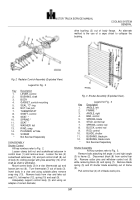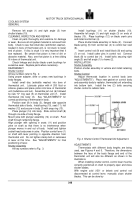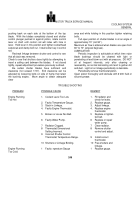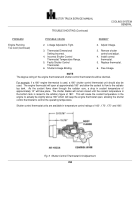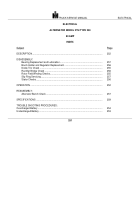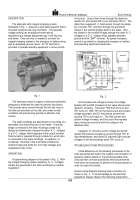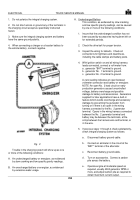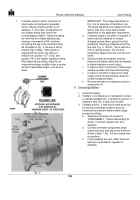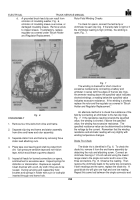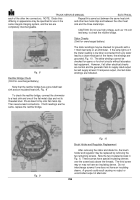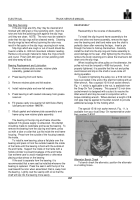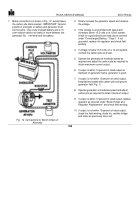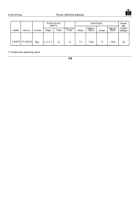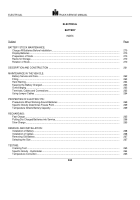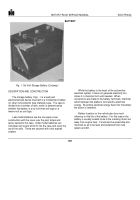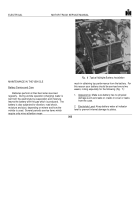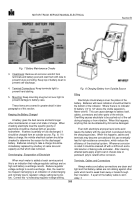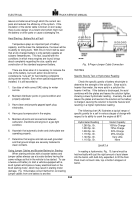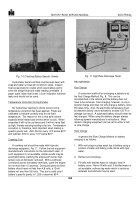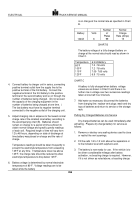TM-5-3805-254-14-P-2 - Page 261 of 894
ELECTRICAL
TRUCK SERVICE MANUAL
Slip Ring Servicing
If the slip rings are dirty, they may be cleaned and
finished with 400 grain or finer polishing cloth.
Spin the
rotor and hold the polishing cloth against the slip rings
until they are clean.
NOTE:
The rotor must be rotated in
order that the slip rings will be cleaned evenly.
Cleaning
the slip rings by hand without spinning the rotor may
result in flat spots on the slip rings, causing brush noise.
Slip rings which are rough or out of round should be
trued in a lathe to .002 inch maximum indicator reading.
Remove only enough material to make the rings smooth
and round.
Finish with 400 grain or finer polishing cloth
and blow away all dust.
Bearing Replacement and Lubrication
1.
Remove retainer plate screws, retainer plate
assembly, gasket and collar.
2.
Press bearing from end frame.
3.
Remove retainer plate and felt washer.
4.
Install retainer plate and new felt washer.
5.
Press bearing in with sealed side away from grease
reservoir.
6.
Fill grease cavity one-quarter full with Delco-Remy
lubricant part number 1948791.
7.
Attach gasket and retainer plate assembly to end
frame using new retainer plate assembly.
The bearing in the slip ring end frame should be
replaced if its grease supply is exhausted.
No attempt
should be made to relubricate and reuse the bearing.
To
remove the bearing from the slip ring end frame, press
out with a tube or collar that just fits inside the end frame
housing.
Press from the outside of the housing towards
the inside.
To install a new bearing, place a flat plate over the
bearing and press in from the outside towards the inside
of the frame until the bearing is flush with the outside of
the end frame.
Support the inside of the frame with a
hollow cylinder to prevent breakage of the end frame.
Use extreme care to avoid misalignment or otherwise
placing undue stress on the bearing
If the seal is separate from the bearing, it is
recommended that a new seal be installed whenever the
bearing is replaced.
Press the seal in with the lip of the
seal toward the rotor when assembled; that is, away from
the bearing.
Lightly coat the seal lip with oil so that the
shaft will slip into the bearing more easily.
REASSEMBLY
Reassembly is the reverse of disassembly.
To install the slip ring end frame assembly to the
rotor and drive end frame assembly, remove the tape
over the bearing and shaft and make sure the shaft is
perfectly clean after removing the tape.
Insert a pin
through the holes to hold up the brushes.
Carefully
install the shaft into the slip ring end frame assembly to
avoid damage to the seal.
After tightening the thru bolts,
remove the brush retaining pin to allow the brushes to fall
down onto the slip rings.
When installing the drive pulley on the alternator, the
pulley nut must be torqued to 4060 foot pounds.
If not
properly tightened, it is possible that the nut and pulley
could loosen and slip on the shaft or even come off
during operation.
To assist in tightening the pulley nut, a 5/16 inch hex
hole is provided in the end of the shaft for holding with an
Allen wrench.
Also a special 15/16 inch socket wrench,
Fig.
11, which is applicable to the nut, is available from
the Snap-On Tool Company.
This special 1/2 inch drive
socket wrench is designed with a cutout to receive the
Allen wrench and may be used in conjunction with a
torque indicating wrench.
Where desired, a length of 3/8
inch pipe may be applied to the Allen wrench to provide
additional leverage for the holding effort.
The special 15/16 inch socket wrench, Fig.
11, is
available from your local Snap- On representative under
their number S-8183.
Back to Top

